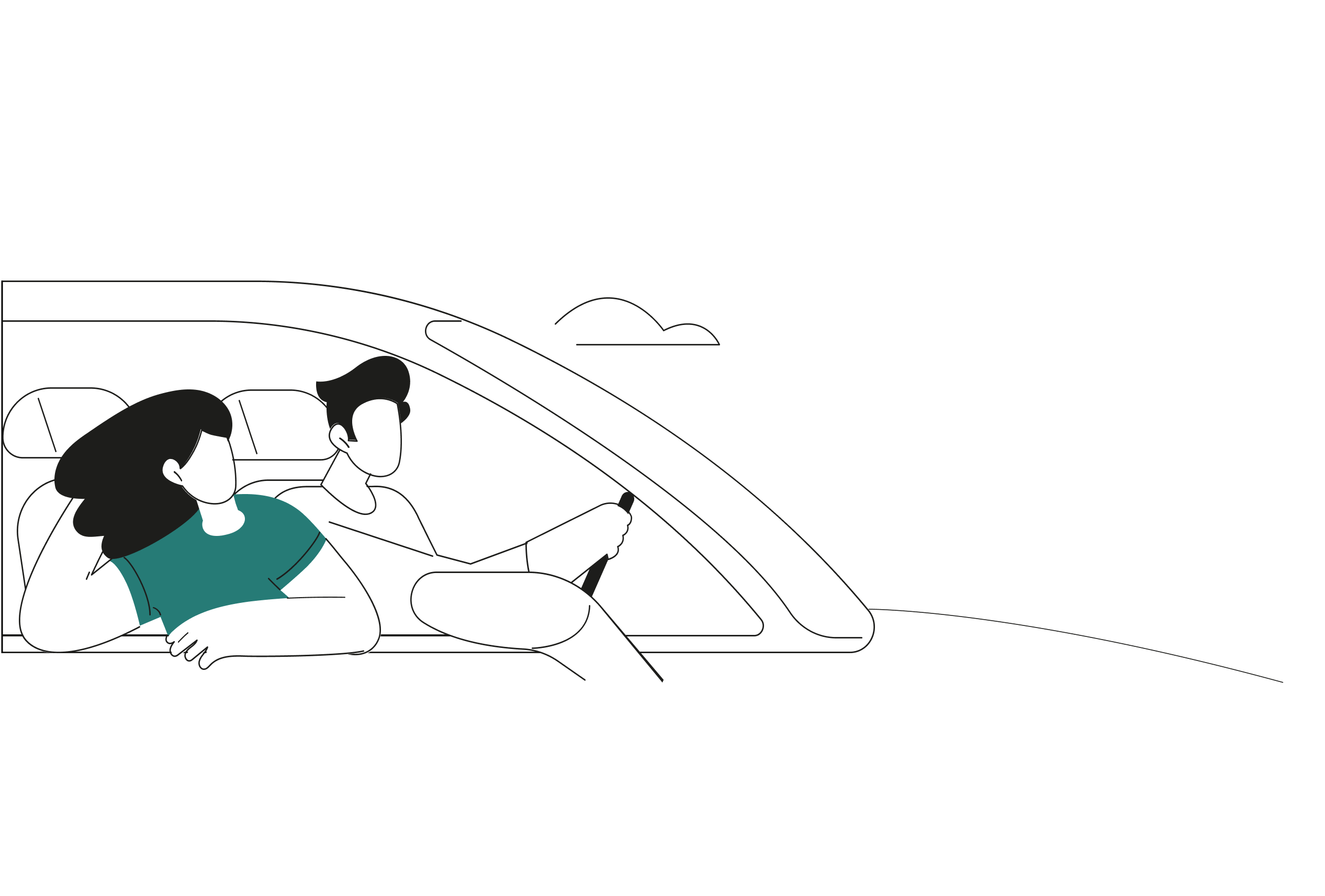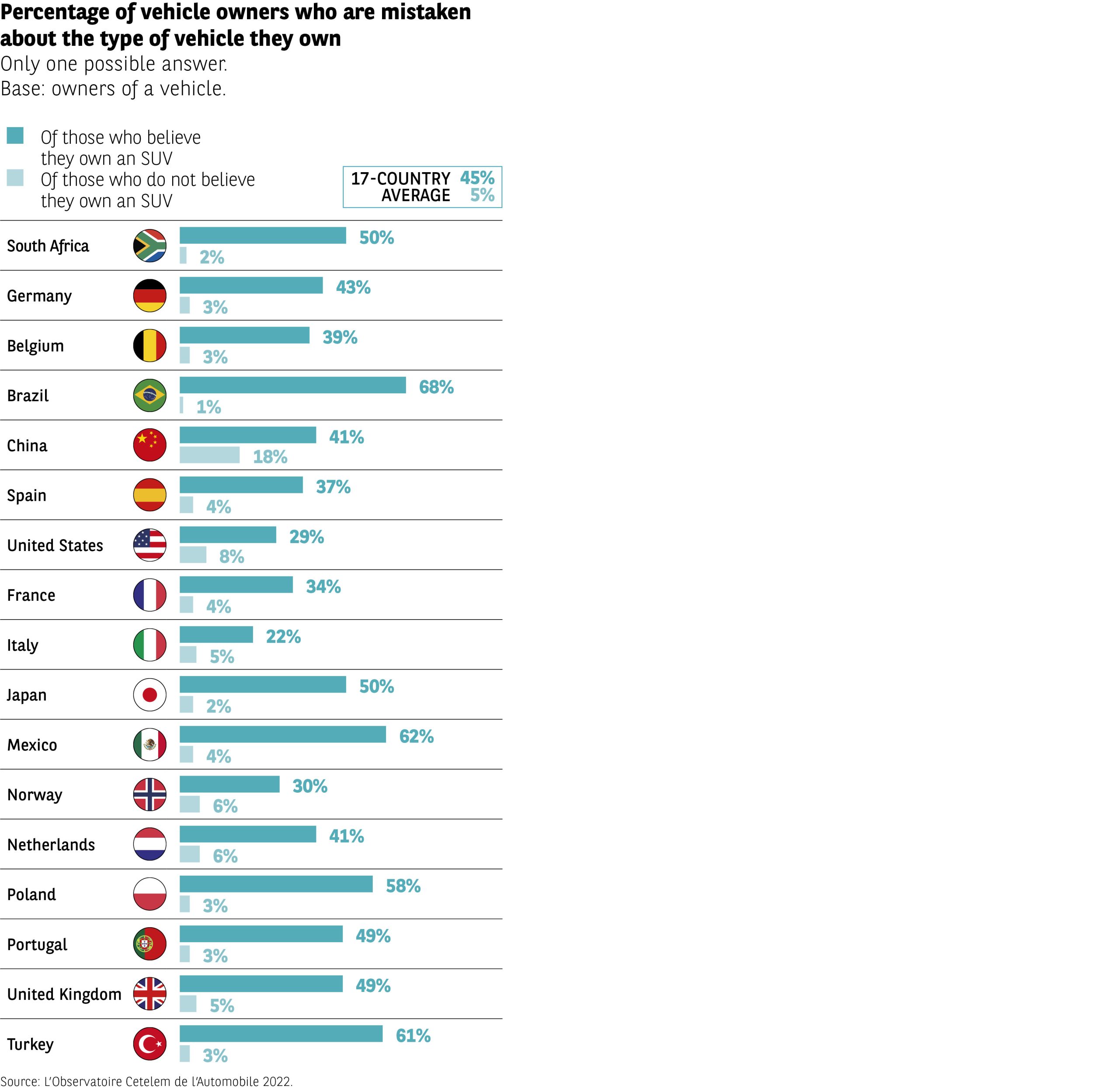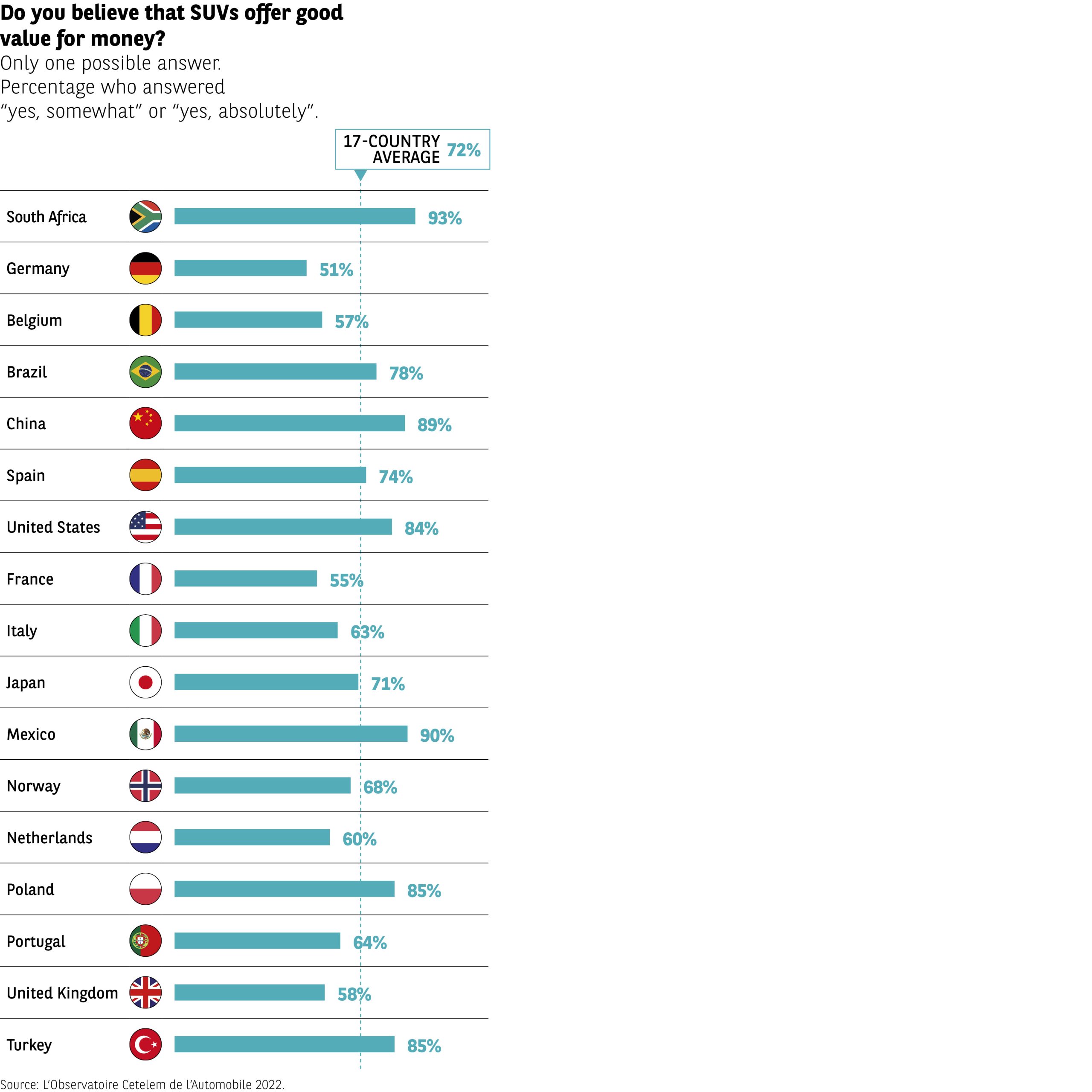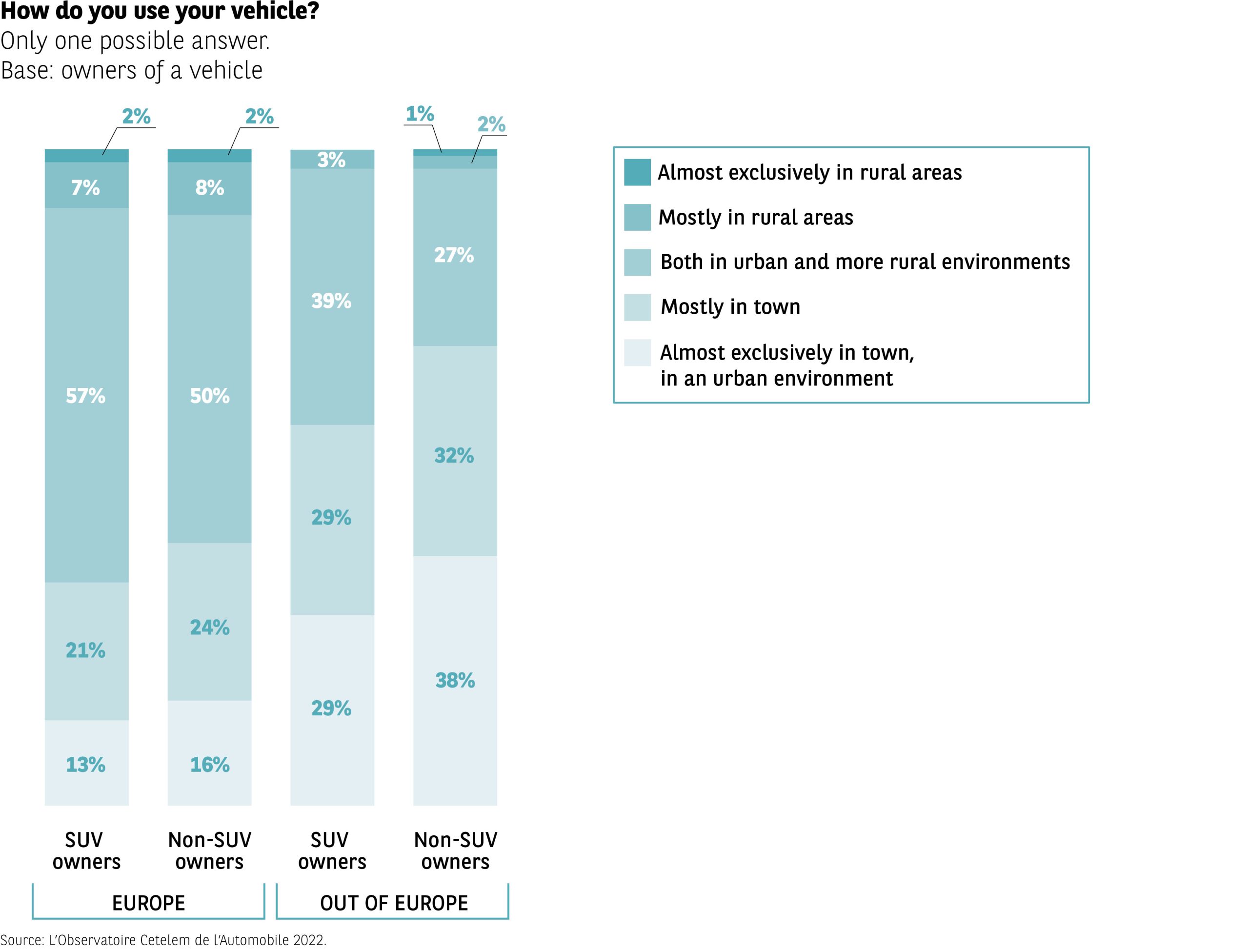An image that varies geographically


Motorists are often incorrect in their belief that they own an SUV
As we have seen, attempting to recognise a vehicle based purely on its silhouette can be a difficult task. However, the answers given by motorists when asked whether or not they own an SUV are even more indicative of the confusion surrounding these vehicles and their identification.
Overall, just 5% of those who do not believe they own an SUV are mistaken about the type of vehicle they have (Fig 2). However, 45% of motorists who think they own an SUV are actually mistaken in their belief. These percentages are practically identical to those obtained when the respondents were asked to identify the silhouettes.
First and foremost, these results highlight great geographical disparity. For example, respondents in Brazil, Mexico and Turkey, three countries with emerging economies, are the most likely to be mistaken (68%, 62% and 61%, respectively). Poland follows close behind, again with a high number of erroneous opinions (58%). In contrast, fewer motorists answer incorrectly in European countries such as Italy, Norway and France (22%, 30% and 34%). The United States, the birthplace of the SUV and the home of the minivan, also boasts a relatively low error rate (29%).
Fig 2 – Misidentification of vehicle type among owners
Download this infographic for your presentations The infographic shows the share of drivers who misidentify their vehicle type, both among those who believe they own an SUV and those who believe they do not. Averages are 45% and 5%.
Among those who believe they own an SUV :
South Africa: 50%
Germany: 43%
Belgium: 39%
Brazil: 68%
China: 41%
Spain: 37%
United States: 29%
France: 34%
Italy: 22%
Japan: 50%
Mexico: 62%
Norway: 30%
Netherlands: 41%
Poland: 58%
Portugal: 49%
United Kingdom: 49%
Turkey: 61%
Among those who believe they do not own an SUV :
Values remain very low across countries, typically between 1% and 8%.
Main insight: misidentification is much more common among people who think they own an SUV.
Source: L’Observatoire Cetelem de l’Automobile 2022.
The infographic shows the share of drivers who misidentify their vehicle type, both among those who believe they own an SUV and those who believe they do not. Averages are 45% and 5%.
Among those who believe they own an SUV :
South Africa: 50%
Germany: 43%
Belgium: 39%
Brazil: 68%
China: 41%
Spain: 37%
United States: 29%
France: 34%
Italy: 22%
Japan: 50%
Mexico: 62%
Norway: 30%
Netherlands: 41%
Poland: 58%
Portugal: 49%
United Kingdom: 49%
Turkey: 61%
Among those who believe they do not own an SUV :
Values remain very low across countries, typically between 1% and 8%.
Main insight: misidentification is much more common among people who think they own an SUV.
Source: L’Observatoire Cetelem de l’Automobile 2022.
Value for money is a key selling point in emerging countries
A similar geographical dichotomy can be observed between emerging and Western countries when it comes to the value for money SUVs offer. This is an attribute on which the South Africans and Mexicans are the most keen, with responses that are not far from unanimous (93% and 90%) (Fig 3). This leading pair are trailed by Turkey, China, Poland, the United States and Brazil, where almost 8 out of 10 motorists appreciate the value for money that SUVs offer. What do most of these countries have in common? Major urban metropolises, vast expanses of land and frequent long journeys by road, factors that go some way to explaining why people opt for a vehicle that has multiple uses and sufficient space for a family that might be quite large. On which more later.
Fig 3 – Perceived value for money of SUVs by country
Download this infographic for your presentations The infographic compares the proportion of people who consider SUVs to offer good value for money. A global average is indicated: 72%.
Country results:
South Africa: 93%
Germany: 51%
Belgium: 57%
Brazil: 78%
China: 89%
Spain: 74%
United States: 84%
France: 55%
Italy: 63%
Japan: 71%
Mexico: 90%
Norway: 68%
Netherlands: 60%
Poland: 85%
Portugal: 64%
United Kingdom: 58%
Turkey: 85%
Main insight: approval is very high in many non-European regions, while Western Europe shows more moderate levels.
Source: L’Observatoire Cetelem de l’Automobile 2022.
The infographic compares the proportion of people who consider SUVs to offer good value for money. A global average is indicated: 72%.
Country results:
South Africa: 93%
Germany: 51%
Belgium: 57%
Brazil: 78%
China: 89%
Spain: 74%
United States: 84%
France: 55%
Italy: 63%
Japan: 71%
Mexico: 90%
Norway: 68%
Netherlands: 60%
Poland: 85%
Portugal: 64%
United Kingdom: 58%
Turkey: 85%
Main insight: approval is very high in many non-European regions, while Western Europe shows more moderate levels.
Source: L’Observatoire Cetelem de l’Automobile 2022.
A variety of uses
The locations in which people use their cars also reveal contrasts between the Western nations and the other countries featured in the survey. Outside Europe, SUVs are mostly driven in town or in urban areas (58%) (Fig 4). The Brazilians and Chinese are by far the most likely to use their vehicle in this way (83% and 72%). Conversely, SUV use in Europe tends to be much less concentrated in cities and their immediate outskirts (34%). In Belgium and the Netherlands, two countries where cyclists rule in towns, just 16% and 20% of SUV drivers use them in urban environments, respectively. Throughout the course of the survey we will see that geographical differences often structure people’s opinions of SUVs.
Fig 4 – Vehicle usage patterns by ownership type
Download this infographic for your presentations The infographic displays how drivers use their vehicles according to five categories:
– almost exclusively rural;
– mainly rural;
– both rural and urban;
– mainly urban;
– almost exclusively urban.
Four groups are compared :
– SUV owners in Europe
– Non-SUV owners in Europe
– SUV owners outside Europe
– Non-SUV owners outside Europe
Values shown:
EUROPE
SUV owners
– 7% almost exclusively rural
– 57% mainly rural
– 21% mixed
– 13% mainly urban
– 2% almost exclusively urban
Non-SUV owners:
– 8% almost exclusively rural
– 50% mainly rural
– 24% mixed
– 16% mainly urban
– 2% almost exclusively urban
OUTSIDE EUROPE
SUV owners:
– 3% almost exclusively rural
– 39% mainly rural
– 29% mixed
– 29% mainly urban
– 1% almost exclusively urban
Non-SUV owners:
– 2% almost exclusively rural
– 27% mainly rural
– 32% mixed
– 38% mainly urban
– 2% almost exclusively urban
The visual highlights greater rural use in Europe, while outside Europe urban and mixed uses dominate.
Source: L’Observatoire Cetelem de l’Automobile 2022.
The infographic displays how drivers use their vehicles according to five categories:
– almost exclusively rural;
– mainly rural;
– both rural and urban;
– mainly urban;
– almost exclusively urban.
Four groups are compared :
– SUV owners in Europe
– Non-SUV owners in Europe
– SUV owners outside Europe
– Non-SUV owners outside Europe
Values shown:
EUROPE
SUV owners
– 7% almost exclusively rural
– 57% mainly rural
– 21% mixed
– 13% mainly urban
– 2% almost exclusively urban
Non-SUV owners:
– 8% almost exclusively rural
– 50% mainly rural
– 24% mixed
– 16% mainly urban
– 2% almost exclusively urban
OUTSIDE EUROPE
SUV owners:
– 3% almost exclusively rural
– 39% mainly rural
– 29% mixed
– 29% mainly urban
– 1% almost exclusively urban
Non-SUV owners:
– 2% almost exclusively rural
– 27% mainly rural
– 32% mixed
– 38% mainly urban
– 2% almost exclusively urban
The visual highlights greater rural use in Europe, while outside Europe urban and mixed uses dominate.
Source: L’Observatoire Cetelem de l’Automobile 2022.
